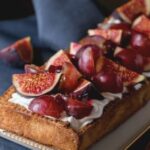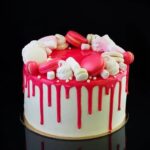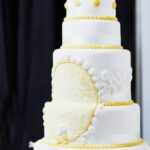Have you ever wondered what flowers can you use to decorate a cake and add a touch of natural beauty to your dessert masterpiece? Edible flowers are not only visually stunning but also offer a unique and delicious way to enhance the presentation of cakes. The use of edible flowers in cake decoration has become increasingly popular, adding a touch of elegance and sophistication to any occasion.
Using edible flowers on cakes is not just about aesthetics; it also holds significance in ensuring that the flowers used are safe for consumption. It’s important to choose flowers that are specifically grown for culinary use, free from pesticides or other harmful chemicals. In this article, we will explore the various types of edible flowers commonly used in cake decorating, as well as provide tips on how to properly prepare them for consumption.
From delicate roses to vibrant pansies, there is a wide range of edible flowers that can be used to adorn cakes and elevate their visual appeal. Each type of flower brings its own unique flavor profile and aesthetic charm to the dessert. Whether you’re looking to create a simple and elegant design or a more elaborate floral arrangement, incorporating edible flowers into your cake decor opens up a world of creative possibilities.
Importance of Using Edible Flowers
When it comes to decorating cakes with flowers, using edible blooms is of utmost importance. The significance of using flowers that are safe for consumption cannot be understated, as it ensures the health and well-being of those enjoying the cake. Edible flowers not only add an aesthetic appeal to desserts but also provide a delightful flavor profile that enhances the overall taste experience.
One of the key considerations when selecting edible flowers for cake decoration is to ensure that they are free from chemicals and pesticides. This means that organic or locally sourced flowers are ideal choices for adorning cakes. Popular edible flowers such as roses, violets, lavender, and pansies are not only visually appealing but also offer unique flavors that can complement the cake’s taste.
In addition to their visual and flavor-enhancing qualities, edible flowers also contain beneficial nutrients such as vitamins and antioxidants. These floral additions can elevate the nutritional value of a cake, making it a more wholesome treat for those indulging in it. By incorporating safe-to-eat flowers into cake decoration, bakers can create stunning designs while prioritizing the well-being of their customers.
| Edible Flower | Commonly Used For |
|---|---|
| Roses | Decorative accent with a subtle floral taste |
| Lavender | Adds a fragrant touch and hint of sweetness |
| Pansies | Bright colors for vibrant cake decorations |
Types of Edible Flowers
When it comes to decorating a cake with flowers, there are various options to choose from that can add not only beauty but also a delightful flavor to your culinary creation. Some popular edible flowers that are commonly used for cake decoration include roses, violets, pansies, chamomile, and lavender. These flowers not only provide a visually appealing aesthetic but also bring unique tastes and aromas to the dessert.
Roses are a classic choice for decorating cakes due to their elegant appearance and delicate scent. Violets and pansies add a burst of color and a slightly floral taste that can complement different flavored cakes.
Chamomile and lavender, on the other hand, offer a more subtle flavor profile that can enhance the overall taste of the cake without overpowering it. It is important to note that when using edible flowers for cake decoration, ensure that they have not been treated with any harmful chemicals or pesticides.
One popular technique for incorporating edible flowers into cake decoration is by placing them individually or in clusters on top of the frosting. Another creative way to use flowers is by freezing them in ice cubes and arranging them around the base of the cake or on top as a decorative element. Experiment with different methods to find what works best for your design aesthetic and taste preferences when decorating with edible flowers.
| Edible Flower | Flavor |
|---|---|
| Roses | Elegant and delicate |
| Violets & Pansies | Colorful with hints of floral taste |
| Chamomile & Lavender | Subtle flavors enhancing the overall taste |
Preparation of Edible Flowers
When it comes to decorating cakes with edible flowers, proper preparation is key to ensuring not only aesthetic appeal but also safety for consumption. Before using flowers as cake decorations, it is essential to clean and prepare them correctly. One of the most important steps in preparing edible flowers for cake decoration is making sure they are free from any chemicals or pesticides that could be harmful if ingested.
Choosing the Right Flowers
Not all flowers are safe for consumption, so it is crucial to select varieties that are specifically labeled as edible. Popular choices for decorating cakes include roses, violets, pansies, lavender, and chamomile. Make sure to source these flowers from reputable suppliers who guarantee they have been grown without the use of pesticides.
Proper Cleaning Techniques
Before using flowers on a cake, they should be gently rinsed under cold water to remove any dirt or debris. It is also advisable to soak them in a bowl of cold water for a few minutes to get rid of any remaining contaminants. Once cleaned, allow the flowers to air dry on paper towels before placing them on the cake.
When incorporating edible flowers into cake decorations, always consider the overall design and theme of the cake. Whether you choose a minimalist approach with a single bloom as a focal point or opt for a more elaborate arrangement, keeping in mind color combinations and placement will help create a visually stunning and appetizing end result for your cake creation.
Techniques for Incorporating Flowers
Decorating a cake with edible flowers can elevate its aesthetic appeal and add a touch of elegance to any special occasion. When it comes to incorporating flowers into cake decorations, there are various techniques that can be used to ensure a visually stunning result. Here are some different methods for arranging and placing flowers on cakes:
- Whole Flowers: One simple yet effective way to decorate a cake with flowers is to place whole blooms strategically on the surface. This method works best with larger flowers such as roses, peonies, or dahlias. Simply ensure that the stems of the flowers are trimmed down to a suitable length before inserting them into the cake.
- Petals and Blossoms: For a delicate and whimsical look, consider using individual petals or small blossoms to create intricate designs on the cake. This technique works well with flowers like pansies, violets, or lavender. You can scatter the petals across the frosting or arrange them in decorative patterns.
- Pressed Flowers: Another popular method for incorporating flowers into cake decorations is by using pressed blooms. Pressing flowers helps preserve their shape and color, making them ideal for adorning cakes. Simply press fresh flowers between two sheets of absorbent paper under weight for a few weeks until they dry out completely.
Whether you choose to go with whole flowers, petals, or pressed blooms, it’s essential to handle the edible flowers with care when decorating cakes. Remember to wash them thoroughly before use and ensure that they are free from pesticides or other harmful chemicals. By employing these various techniques for arranging and placing flowers on cakes, you can create visually stunning confections that not only look beautiful but also taste delicious.
Incorporating edible flowers into cake decorations allows for endless creativity and customization options. Whether you prefer a minimalist design with a few carefully placed blooms or a more elaborate floral arrangement cascading down the sides of the cake, there are limitless possibilities when it comes to using flowers as decoration.
Experiment with different techniques and flower varieties to discover what works best for your desired aesthetic. Remember, when decorating cakes with edible flowers, always prioritize food safety by using organic blooms that are safe for consumption.
Color Combinations
Understanding Color Theory
Before diving into decorating a cake with flowers, it is essential to understand the basics of color theory. Different colors evoke different emotions and moods, so it’s important to choose a color scheme that complements the overall theme of the cake.
For example, using pastel-colored flowers like lavender or baby’s breath can create a soft and romantic look, perfect for weddings or bridal showers. On the other hand, vibrant and bold colored flowers such as red roses or sunflowers can add a pop of color and energy to birthday cakes or celebratory desserts.
Complementary Color Schemes
When selecting flowers to decorate a cake, one popular choice is to use complementary colors. Complementary colors are hues that are opposite each other on the color wheel, creating a visually striking effect when paired together.
For instance, if the cake frosting is predominantly yellow, adding purple pansies or violet orchids can create a beautiful contrast that instantly grabs attention. Similarly, pairing orange marigolds with blue hydrangeas can create a stunning visual impact that enhances the overall appeal of the cake.
Monochromatic Color Schemes
Another option for using flowers to decorate cakes is to stick to a monochromatic color scheme. This involves selecting flowers in varying shades of the same color family to create a harmonious and sophisticated look. For example, using different hues of pink roses ranging from pale blush to deep magenta can add depth and dimension to a floral cake design. Monochromatic color schemes are versatile and work well for any occasion, from elegant garden parties to chic modern celebrations.
Incorporating flowers into cake decoration is not only visually pleasing but also adds a touch of elegance and freshness to any dessert. By understanding color theory and experimenting with complementary or monochromatic color schemes, you can elevate your cake decorating skills and create stunning confections that will impress your guests. Next time you’re wondering what flowers can you use to decorate a cake, consider exploring different color combinations to achieve an eye-catching and beautiful result.
Safety Precautions
When it comes to decorating cakes with flowers, one of the most crucial aspects to consider is ensuring that the flowers are safe for consumption. Using edible flowers not only enhances the visual appeal of the cake but also allows for a delightful gastronomic experience.
It is important to remember that not all flowers are suitable for consumption, as some may contain toxins or pesticides that can be harmful if ingested. This is why it is essential to source your flowers from reputable suppliers or ensure that they are organic and specifically labeled as edible.
There are several popular edible flowers that are commonly used for cake decoration, such as roses, violets, lavender, pansies, and chamomile. These blossoms not only add a pop of color and elegance to the cake but also infuse subtle floral notes that complement the sweetness of the dessert. Before using any flower on a cake, it is imperative to research and confirm its edibility.
Some flowers may look appealing but could be toxic if consumed. Additionally, it is advisable to wash the flowers thoroughly in cool water and gently pat them dry before placing them on the cake.
To avoid any potential health risks, make sure that the edible flowers you use for decorating cakes are pesticide-free. Pesticides can be harmful when ingested, so it is best to either grow your own organic flowers or purchase them from reputable sources known for their culinary blooms.
Another option is to seek out specialty stores or farmers’ markets that offer a variety of edible flowers specifically grown for culinary use. By taking these safety precautions, you can confidently adorn your cakes with beautiful blooms without compromising on food safety standards.
Alternative Options
When it comes to decorating cakes, edible flowers are not the only option available. There are other delicious and visually appealing edible decorations that can be used in conjunction with flowers to create stunning cake designs. Here are some alternative options to consider when enhancing your cake with extra flair:
- Berries: Fresh berries such as strawberries, blueberries, raspberries, or blackberries can add a burst of color and juicy sweetness to your cake design. They can be placed strategically alongside edible flowers for a more vibrant and textured look.
- Chocolate: Whether in the form of shavings, curls, or ganache drizzles, chocolate is a classic decoration that pairs well with flowers on cakes. Dark chocolate, white chocolate, or even colorful candy melts can bring richness and elegance to your creation.
- Nuts: Toasted almonds, pecans, pistachios, or hazelnuts can provide a crunchy contrast to the soft texture of cake and frosting. Chopped nuts or praline crumbs can be sprinkled around floral arrangements for added texture and flavor.
Incorporating these alternative edible decorations along with flowers on your cakes not only enhances their visual appeal but also introduces a variety of flavors and textures for a more dynamic eating experience. Experimenting with different combinations of flowers, berries, chocolate, and nuts can result in unique and personalized cake designs that cater to different tastes and preferences.
Remember to consider the overall theme and taste profile of your cake when selecting which edible decorations to use in conjunction with flowers. By mixing and matching these elements thoughtfully, you can create a visually stunning masterpiece that is as delightful to look at as it is to eat.
Inspiration and Ideas
Decorating cakes with flowers can truly elevate the overall look and appeal of your baked creation. The use of edible flowers adds a touch of elegance and natural beauty that is hard to replicate with other decorations. The question of what flowers can you use to decorate a cake is an important one, not only for aesthetic purposes but also for ensuring the safety of those who will be enjoying the dessert.
When it comes to selecting flowers for cake decoration, there are several popular options that are both visually stunning and safe for consumption. Flowers such as roses, violets, pansies, and lavender are commonly used in creating beautiful floral arrangements on cakes. These flowers not only add a pop of color but also bring a delicate fragrance to the dessert.
To incorporate edible flowers into your cake decoration, it is essential to properly clean and prepare them beforehand. Make sure to wash the flowers thoroughly to remove any dirt or chemicals. Additionally, it is crucial to ensure that the flowers are pesticide-free and sourced from reputable suppliers to guarantee their safety for consumption. By following these preparation steps, you can create a stunning floral display on your cake that will surely impress your guests.
Frequently Asked Questions
What Flowers Are Safe to Put on Cakes?
Some flowers that are safe to put on cakes include roses, violets, pansies, and marigolds. It is important to make sure the flowers are organic and free from pesticides.
What Flowers Are Edible to Decorate a Cake?
Edible flowers that can be used to decorate a cake include lavender, calendula, chamomile, and nasturtiums. These flowers not only add a visually appealing touch but also provide unique flavors to the dessert.
Which Flower Is Used for Cake Decoration?
One of the most popular flowers used for cake decoration is the rose. Roses come in various colors and sizes, making them versatile for different cake designs. Their delicate petals can add a sophisticated and elegant look to any baked creation.

Welcome to my blog about home and family. This blog is a place where I will share my thoughts, ideas, and experiences related to these important topics. I am a stay-at-home mom with two young children. I hope you enjoy reading it! and may find some helpful tips and ideas that will make your home and family life even better!





